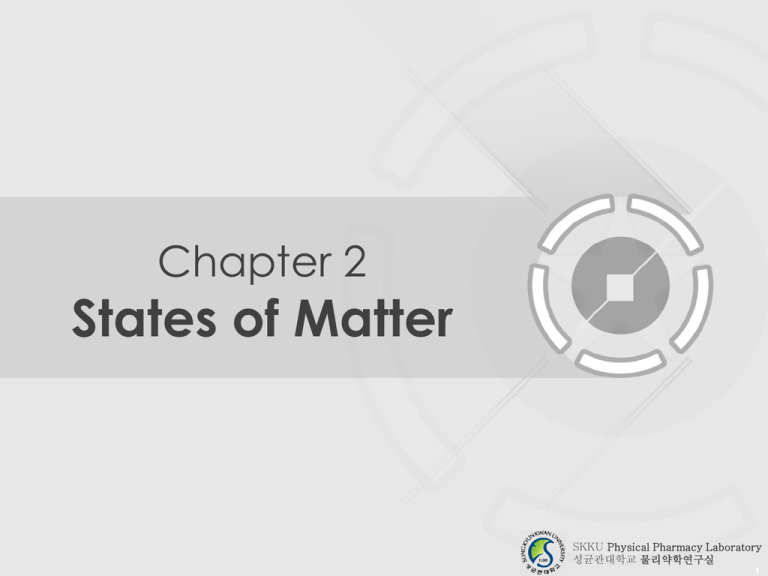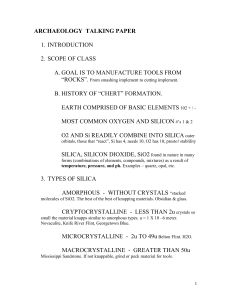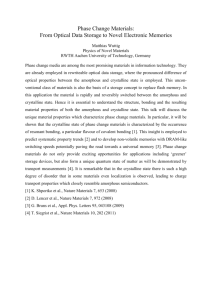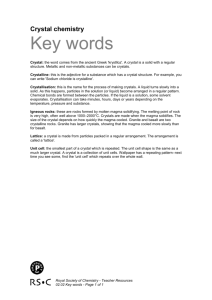States of Matter
advertisement

Chapter 2 States of Matter SKKU Physical Pharmacy Laboratory 성균관대학교 물리약학연구실 1 Contents Binding forces between molecules • Intramolecular forces • Intermolecular forces States of matter • The liquid state • Solids and the crystalline state • The liquid crystalline state • The supercriticial fluid state • Phase equilibria & the phase rule 2 Binding forces between molecules Intramolecular forces Intermolecular forces Binding forces 4 Intramolecular forces Ionic bonds Covalent bonds Polar covalent bonds Intermolecular forces Van der Waals forces Ion-dipole & Ion-induced dipole Forces Hydrogen bonds Cohesion Adhesion Repulsive & attractive energies 5 Fig. 2-1 Chemical bonds 6 Ionic bonds Covalent bonds Polar covalent bonds Van der Waals forces 7 Neutral Molecule Induced-Dipole London Induced-Dipole Dipole Keesome Dipole Induced-Dipole Debye Dipole Ion-dipole & ion-induced dipole forces 8 Na+ Dipole Cl- Dipole Na+ Induced-Dipole Hydrogen bonds 9 Fig. 2-4 States of matter The liquid state The liquid state 11 Liquefaction of gases Critical Temperature Above this temperature, a liquid can no longer exist. Critical Pressure The pressure required to liquefy a gas at its critical temperature Ex) H2O (647 K, 218 atm) He (5.2 K, 2.26 atm) Aerosols 12 1 atm 1 - 6 atm Drug + Propellant Vapor pressure of liquids 13 V.P. vs. Temp. Fig. 2-5 Clausius-Clapeyron equation 14 The relationship between the vapor pressure and the absolute temperature of a liquid P1 H v (T2 T1 ) log P2 2.303RT1T2 ∆𝐻𝑣 1 ln 𝑃 = − + 𝑐𝑜𝑛𝑠𝑡𝑎𝑛𝑡 𝑅 𝑇 Eqn 2-15 Eqn 2-16a H: Heat of vaporization States of matter Solids & the crystalline state Crystal systems 16 Cubic (NaCl) 입(등)방정계 Tetragonal (Urea) 정방정계 Hexagonal (Iodoform) 육방정계 Rhombic (Iodine) 사방정계 Monoclinic (Sucrose) 단사정계 Triclinic (Boric acid) 삼사정계 * Fast track – Physical Pharmacy Alexander T Florence and David Attwood Crystal structures 17 Ionic & atomic crystal Molecular crystal Hard, brittle and high m.p. Soft and low m.p. Metallic crystal + + + + + + + + + + + + + + + + + + Polymorphism (다형) 18 • Polymorphic Some elemental substances exist in more than one crystalline form Formulation of polymorphs Nature of solvent Difference of physicochemical properties Crystal shape Optical property Temperature Rate of cooling Heating Solubility Boling Dissolution rate Solid state stability Van der Waals forces Hydrogen bonds Psudopolymorphs (solvates) Polymorphism 19 Spiperone 2 polymorphs Dimer (molecules in pairs) Nondimerized molecules X-ray powder diffraction pattern 20 Form I Form II Losartan 고혈압치료제(MSD 코자) Polymorphism 21 Theobroma oil (cacao butter) 4 polymorphism forms (Polymorphs) α - form γ - form 15 β - form β' - form 20 25 30 Melting point, ºC 35 40 γ - form – melting at 18 ºC, unstable α - form – melting at 22 ºC , unstable β' - form – melting at 28 ºC , unstable β - form – melting at 34.5 ºC, stable Used for stable suppository Polymorphism 22 Enantiotropic polymorphism • The change from one form to another is reversible. Metastable form Stable form Monotropic polymorphism • The transition takes place in one direction only. Metastable form Stable form Amorphous solids 23 Def) Amorphous solids may be considered as supercooled liquids in which the molecules are arranged in a random manner somewhat as in the liquid state. Crystals (except cubic crystals) • Anisotropic – show different characteristics in various directions along the crystal Amorphous solids (+ cubic crystals) • Isotropic – exhibit similar properties in all directions Amorphous solids 24 Differ from crystalline solids Tend to flow when subjected to sufficient pressure Do not have definite melting point Ex) Novobiocin acid Crystalline form : poorly absorbed No activity Amorphous form : readily absorbed Therapeutically active Amorphous form: prompt action Crystalline form: long action Insulin zinc suspension(Lente) AF:CF=30:70 24h effect Insulin formulation X-ray diffraction 25 Laue or Transmission method Bragg or Reflection method Boiling point & Melting point 26 짝수 홀수 Fig. 2-14 Van der Waals forces Hydrogen bonds States of matter The liquid crystalline state Liquid crystals 28 State of matter that have properties between those of a conventional liquid and those of a solid crystal Thermotropic liquid crystal • Phase transition into liquid crystal phase as temperature is changed. Lyotropic liquid crystal • Phase transition as a function of both temperature and concentration Thermotropic liquid crystals 29 Produced when certain substances are heated Three types of thermotropic liquid crystals Nematic (thread-like) liquid crystals Orientate with long axes parallel, but not ordered into layers Mobile and orientated by electric or magnetic fields * Physiochemical Principles of Pharmacy 4th edition Alexander T Florence and David Attwood Thermotropic liquid crystals 30 2. Smectic (soap-like) liquid crystals Arrange with long axes parallel, also arranged into layers Viscous and not oriented by magnetic fields * Physiochemical Principles of Pharmacy 4th edition Alexander T Florence and David Attwood Thermotropic liquid crystals 31 3. Cholesteric (chiral nematic) liquid crystals Formed by several cholesteryl esters Stack of very thin two-dimensional nematic-like layers Nematic-like layer * Physiochemical Principles of Pharmacy 4th edition Alexander T Florence and David Attwood Thermotropic liquid crystals 32 Smectic Liquid Crystals Nematic Liquid Crystals Cholesteric Liquid Crystals Lyotropic liquid crystals 33 The liquid crystalline phases that occur on increasing the concentration of surfactant solutions As increase of concentration of surfactant Spherical micelle elongated or rod like micelle hexagonal phase (middle phase) cubic phase (with some surfactants) neat phase (lamellar phase) * Physiochemical Principles of Pharmacy 4th edition Alexander T Florence and David Attwood States of matter The supercritical fluid state Supercritical fluid 35 Intermediate between those of liquids and gases Gas-like property • Better ability to permeate solid substances Liquid-like property • High densities that can be regulated by pressure Pressure↑ Density of the gas↑, Ability to dissolve compounds↑ Supercritical fluid 36 Fig. 2-16 Supercritical fluid 37 Pharmaceutical applications Extraction Crystallization Preparation of formulations Preparation of polymer mixtures Formulation of micro- and nanoparticles Example 38 Decaffeination of coffee Traditionally, solvents like methylene chloride have been used. Expensive, toxic Utilization of supercritical CO2 Reduced cost and toxicity Adding water to supercritical CO2 Reduced the loss of the flavor Supercritical fluid 39 Fig. 2-17 States of matter Phase equilibria & the phase rule The phase rule (계를 완전히 설명하기 위하여 고정해야 하는 변수들의 최소한 자유도의 수) 41 𝐹 =𝐶−𝑃+2 F is the number of degrees of freedom in the system C is the number of components P is the number of phases present Phase diagram for water 42 Fig. 2-22 Condensed systems 43 Systems in which the vapor phase is ignored and only solid and/or liquid phases are considered are termed condensed systems Two component systems containing liquid phases I 44 Water vs. Phenol Upper Consolute Temperature Fig. 2-23 Two component systems containing liquid phases II 45 Water vs Triethylamine Fig. 2-24 Water vs Nicotine Fig. 2-25 Two component systems containing solid & liquid phases: Eutectic mixtures 46 Eutectic mixture A mixture of chemical compounds has a single chemical composition that solidifies at a lower temperature than any other composition. Eutectic point The component ratio that exhibits the lowest observed melting point Typical phase diagram of eutectic mixture Two component systems containing solid & liquid phases 47 Fig. 2-26 Eutectic mixtures 48 Eutectic Mixture of Local Anesthetics (EMLA) The eutectic system of Lidocaine / Prilocaine Eutectic point – 1:1 mixture Eutectic temperature – 18 ºC A mixed local anesthetic that can be used for topical application EMLA Cream (AstraZeneca) Menthol + Testosterone Solid dispersion 49 Definition The dispersion of one or more active ingredients in an inert carrier or matrix at solid state Solid dispersion type Matrix Drug * ** I Eutectics C C II Amorphous precipitations in crystalline matrix C A III Solid solutions C M I V Glass suspension A C V Glass suspension A A V I Glass solution A M * A: matrix in the amorphous state, C: matrix in the crystalline state ** A: drug dispersed as amorphous clusters in the matrix, C: drug dispersed as crystalline particles in the matrix, M : drug molecularly dispersed throughout the matrix Solid dispersion 50 Solid solution Each solid phase contains both components A solid solute is dissolved in a solid solvent Higher, lower, or unchanged melting behavior depending upon the degree of interaction between components Mixed amorphous or glass solutions Molecular dispersion of one component in another where the overall solid is amorphous Exhibit an intermediate glass transition temperature Solid dispersion 51 Advantages Reduction of particle size Increased wettability of the material Reduced aggregation and agglomeration Increase in solubility of the drug Facilitating the dissolution and the bioavailability of poorly soluble drugs Rate of solution of griseofulvin solid solutions, eutectic and crystalline material Phase equilibria in threecomponent systems 52 𝐹 =𝐶−𝑃+2 𝐹 =3−1+2=4 Condensed system & constant temperature 𝑭=𝟐 Triangular diagrams 53 Fig. 2-27 Triangular diagram of microemulsion 54 Partially Miscible Liquids 55 Fig. 2-28 Solvent effects Fig. 2-29 Temperature effects







